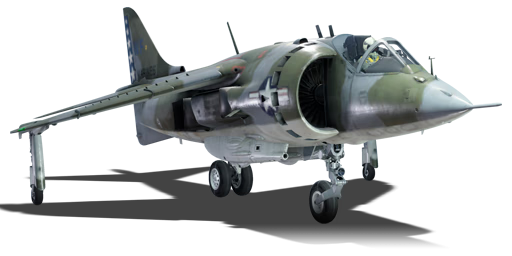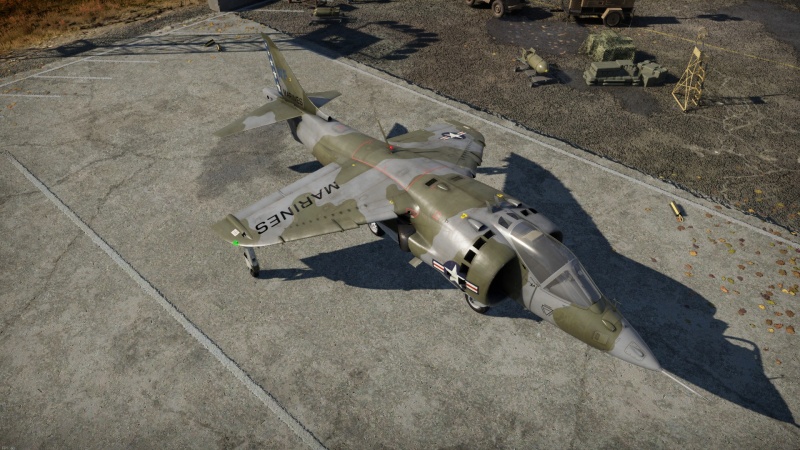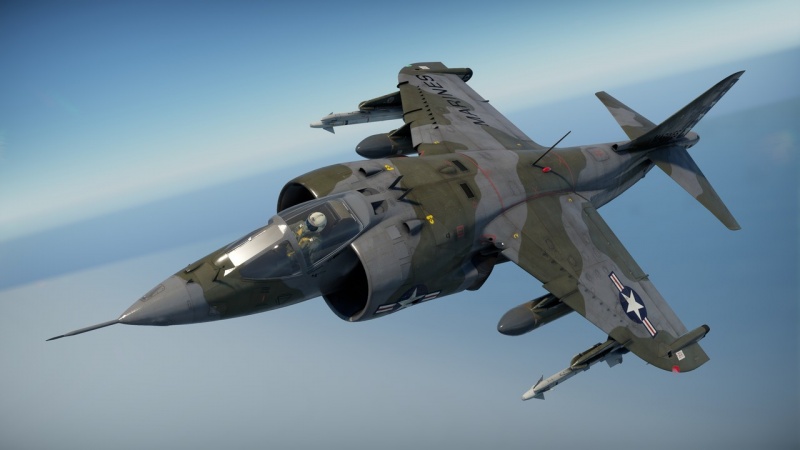AV-8A
| This page is about the American jet fighter AV-8A. For other versions, see Harrier (Family). |
Contents
Description
The AV-8A Harrier is a premium gift rank VI American jet fighter with a battle rating of 9.3 (AB) and 9.7 (RB/SB). It was introduced in Update "New Power". Like all members of the Harrier family the AV-8A is a VTOL aircraft with thrust vectoring nozzles, which allow it to take off and land vertically.
General info
Flight performance
| Characteristics | Max Speed (km/h at 0 m - sea level) |
Max altitude (metres) |
Turn time (seconds) |
Rate of climb (metres/second) |
Take-off run (metres) | |||
|---|---|---|---|---|---|---|---|---|
| AB | RB | AB | RB | AB | RB | |||
| Stock | 1,151 | 1,145 | 12192 | 32.2 | 33.1 | 81.7 | 75.2 | 550 |
| Upgraded | 1,164 | 1,156 | 31.7 | 32.0 | 102.7 | 87.0 | ||
Details
| Features | |||||
|---|---|---|---|---|---|
| Combat flaps | Take-off flaps | Landing flaps | Air brakes | Arrestor gear | Drogue chute |
| X | ✓ | ✓ | ✓ | X | X |
| Limits | ||||||
|---|---|---|---|---|---|---|
| Wings (km/h) | Gear (km/h) | Flaps (km/h) | Max Static G | |||
| Combat | Take-off | Landing | + | - | ||
| 1191 | 648 | N/A | 833 | 556 | ~14 | ~6 |
| Optimal velocities (km/h) | |||
|---|---|---|---|
| Ailerons | Rudder | Elevators | Radiator |
| < 648 | < 950 | < 790 | N/A |
Engine performance
| Engine | Aircraft mass | ||||||
|---|---|---|---|---|---|---|---|
| Engine name | Number | Basic Mass | Wing loading (full fuel) | ||||
| Rolls-Royce F402-RR-401 | 1 | 5,918 kg | 439 kg/m2 | ||||
| Engine characteristics | Mass with fuel (no weapons load) | Max Takeoff Weight | |||||
| Weight (each) | Type | 10m fuel | 20m fuel | 30m fuel | 34m fuel | ||
| 1,640 kg | Vectored-thrust low-bypass turbofan | 6,605 kg | 7,292 kg | 7,978 kg | 8,253 kg | 12,679 kg | |
| Maximum engine thrust @ 0 m (RB / SB) | Thrust to weight ratio @ 0 m (WEP) | ||||||
| Condition | 100% | WEP | 10m fuel | 20m fuel | 30m fuel | 34m fuel | MTOW |
| Stationary | 9,071 kgf | 9,625 kgf | 1.46 | 1.32 | 1.21 | 1.17 | 0.76 |
| Optimal | 9,071 kgf (0 km/h) |
9,625 kgf (0 km/h) |
1.46 | 1.32 | 1.21 | 1.17 | 0.76 |
| The F402-RR-401 engine loses a significant amount of thrust as your speed increases |
Survivability and armour
The AV-8A has no armour. The engine and all fuel tanks are packed in a tight cluster in the centre of the fuselage.
Modifications and economy
Armaments
Offensive armament
The AV-8A is armed with:
- 2 x 30 mm ADEN Mk.4 cannons, belly-mounted (200 rpg = 400 total)
Suspended armament
The AV-8A can be outfitted with the following ordnance:
- Without load
- 5 x 250 lb LDGP Mk 81 bombs (1,250 lb total)
- 5 x 500 lb LDGP Mk 82 bombs (2,500 lb total)
- 2 x 1,000 lb LDGP Mk 83 bombs (2,000 lb total)
- 2 x 1,000 lb LDGP Mk 83 bombs + 3 x 500 lb LDGP Mk 82 bombs (3,500 lb total)
- 2 x AIM-9G Sidewinder missiles
- 28 x FFAR Mighty Mouse rockets
- 76 x FFAR Mighty Mouse rockets
- 16 x Zuni Mk32 Mod 0 ATAP rockets
- 2 x AIM-9G Sidewinder missiles + 3 x 250 lb LDGP Mk 81 bombs (750 lb total)
- 2 x AIM-9G Sidewinder missiles + 3 x 500 lb LDGP Mk 82 bombs (1,500 lb total)
- 2 x AIM-9G Sidewinder missiles + 2 x 1,000 lb LDGP Mk 83 bombs (2,000 lb total)
- 2 x AIM-9G Sidewinder missiles + 2 x 1,000 lb LDGP Mk 83 bombs + 1 x 500 lb LDGP Mk 82 bomb (2,500 lb total)
- 2 x AIM-9G Sidewinder missiles + 14 x FFAR Mighty Mouse rockets
- 2 x AIM-9G Sidewinder missiles + 38 x FFAR Mighty Mouse rockets
- 2 x AIM-9G Sidewinder missiles + 8 x Zuni Mk32 Mod 0 ATAP rockets
Usage in battles
The AV-8A can be considered a multirole aircraft which can focus in air-to-air combat, air to ground combat and air to sea combat. Its firepower and ordnance make it a competitive aircraft in all game modes. The roles can be divided in such:
When air to air:
The Harrier has access to AIM-9G Sidewinder air to air missiles capable of taking down all enemy aircraft in the game. It should be noted that the AIM-9G is a rear-aspect lock-on missile, meaning the Harrier must be behind the enemy aircraft to be able to launch the missile.
When facing enemy bombers:
Enemy bombers are the easiest targets for the Harrier both in gun strafe and when using missiles as they lack agility when dogfighting against the Harrier and countermeasures such as flares to be able to counter the missiles. It is unlikely to face enemy bombers besides the Vautour IIA IDF/AF as most of them stay at 8.0. AI-controlled bombers are the exception.
When facing enemy attackers:
When facing player-controlled attackers (not neccesarily planes labelled as attackers but planes who focus on ground striking), the pilot must stay aware that, besides the Harrier superior mobility, they can outturn you as they will often fly at lower speeds than you, meaning their turn radius compared to yours will be much smaller. Most of the enemy planes that do CAS runs will often be enemy fighters (not labelled as attackers) but with ground ordnance, meaning they can or will be heavier than you, increasing drag and reducing agility when in a dogfight, use this as an advantage.
As an attacker/bomber:
The Harrier has access to a wide variety of ground ordnance capable of destroying enemy ground units and bases. It also has access to CCIP ballistics computer (refer to Ballistic Computer for explanation) meaning the pilot has access to ground ordnance crosshairs which will increase ordnance accuracy, both rockets and bombs. It is not recommended to fly as a bomber (in terms of altitude) but fly as a tree cutter (as close to the ground as possible). This is recommended to achieve multiple things: radar interference, max speed, reduce enemy visibility and awareness. It also makes bombing easier without the need of ballistics computer (although it is recommended to use it since it will not require any practice). Time fuze MUST BE ADDED to avoid assault fuze explosion, risking your plane to be hit by the explosion causing a death. Ground striking ordnance should be taken at pilot's discretion, but it is recommended to take the 2 x 1000 lb and 3 x 500lb bombs in order to take a whole base completely and still maintain high speeds. It should be notted that you are unable to carry any sort of anti-air missiles with this payload.
*Note: radar interference is mostly irrelevant in air realistic battles as the plane will still be highlighted and enemy pilots could use eye aiming. However, it will interfere with radar homing missiles (SARH missiles such as AIM-7E, R-3R, etc carried by F-4 Phantoms and MiG-21's) and will be your main line of defence when flying in simulator battles, you will be able to fly stealthily if flying in tree cutting tactic.
When in combined battles (ground realistic battles):
This is where the Harrier is able to shine as an attacker, primarily using VTOL and hovering mode to an advantage (will be explained more detailed later). There is multiple loadouts which can be used in order to make the Harrier a scary attacker.
Bomb payload:
This is often the most used payload for multiple reasons: has the biggest explosion radius compared to rockets, are more forgiving when missing by couple meters, can take multiple targets with a single bomb. The use of ballistics computer makes their aiming much easier than with eye aiming both in realistic and simulator battles. The x4 1000lb bombs are recommended as, if aimed correctly, will destroy one or multiple enemy targets with a single bomb, meaning you are able to get at least 2 kills (as bombs drop in pair)
Rocket payload:
This is the trickiest but most rewarding payload the Harrier can carry (rewarding as it is able to make much more kills than bombs). Tanks can be taken with one to three rocket salvos (launched in pairs, meaning with 2 to 6 rockets in total). This means you are able to get 12 kills (considering you take 6 rockets per tank) if you take the 76 x Might Mouse rocket payload.
VTOL trick:
Harrier can be used as a helicopter thanks to the VTOL capabilities, rockets are recommended if used like this. It is able to hide behind mountains, poke to attack and go back into cover as a helicopter would do. Handling this technique can be tricky and will require practice but is an alternate way of playing CAS.
*Note: AIM-9G are not recommended to be taken in GRB as most of the air to air engagements will be within a kilometre range specially since the AIM-9G turn radious is really narrow, meaning enemy planes can be taken with the 30 mm ADEN autocannons or be taken by friendly SPAA. It is not recommended to use them against enemy helicopters either as the autocannons are sufficient for them.
Pros and cons
Pros:
- VTOL capabilities
- AIM-9Gs have a max G overload of 16
- 16 different payload options
- Powerful 30 mm ADEN cannons
Cons:
- Heavy airframe, loses some speed in turns
- Only gets two anti-air missiles in all loadouts
- Limited WEP, lack of afterburner
- Using thrust vectoring in combat bleeds speed
History
The US military had been paying close attention to the development of British VTOL aircraft through the 1950s / 60s, taking part in the testing and evaluation of the Hawker Siddeley P.1127 / Kestrel FGA.1 (prototypes that would eventually develop into the Harrier) in the mid-1960s. At the 1968 Farnborough air show two United States Marine Corps (USMC) pilots, Col. Thomas H. Miller (eventually promoted to Lieutenant General) and Lt. Col. Bud Baker unexpectedly arrived at the Hawker Siddeley Aviation (HSA) chalet and announced they had been sent to test fly the new Harrier GR.1 aircraft. Within 2 weeks of the show both pilots had flown the Harrier and shortly after returned to the US with a very positive report of the aircraft.[1]
Within three months of the report a team of US test pilots were in the UK evaluating the Harrier and within a further five months the US had declared its intention to buy 110 Harriers by the mid 1970s. The US congress originally insisted that the Harriers should be built in the US, leading to HSA signing a 15 year agreement with McDonnell-Douglas, where McDonnell-Douglas would build the aircraft in the US and both parties would share data and designs of any aircraft related to the Harrier.[1] However later, after realizing the cost increase that would come from shifting production to the US, it was instead decided all 110 aircraft would be built by HSA in the UK. The aircraft would be purchased as "off the shelf" products with only limited modifications made from the Harrier GR.1. The US Harriers would have the more powerful Pegasus Mk 103 engine, the ability to carry two Sidewinder missiles, and other minor changes such as US radio equipment.[1]
The Harrier entered service with the USMC in 1971, under the designation AV-8A.[1]Marine Attack Squadron 513 (VMA-513) was the first squadron to receive its Harriers with VMA-231 and VMA-542 following. Shortly after it entered service the US decided to replace the British Ferranti FE 541 Inertial Navigation and Attack System (INAS) system with an American system known as "baseline". The FE 541 was an advanced system, it was able to use inertial navigation to plot the Harrier's location on a moving map in the cockpit and had various weapons aiming modes to allow for accurate bombing. The US however did not like the FE 541 finding it too complicated and difficult to maintain. In addition the FE 541 required a calibration process to be carried out before use, which could not be completed onboard a ship, severely limiting it's usefulness to the USMC. The baseline system was far simpler than the FE 541 and did not provide navigation functionality; with the removal of the large moving map display the USMC took the opportunity to change the layout of the AV-8A's cockpit making it different to that in British Harriers.[1]
Media
Excellent additions to the article would be video guides, screenshots from the game, and photos.
See also
External links
Citations
Bibliography
- Fozard, J. (1978). The British Aerospace Harrier Case Study in Aircraft Design. American Institute of Aeronautics & Astronautics.
| Hawker Aircraft Limited | |
|---|---|
| Biplane fighters | |
| Fury | Fury Mk I · Fury Mk II |
| Nimrod | Nimrod Mk I · Nimrod Mk II |
| Scout plane | Osprey Mk IV |
| Piston fighters | |
| Hurricane | Hurricane Mk I/L · Hurricane Mk.I/L FAA M · Sea Hurricane Mk IB · Sea Hurricane Mk IC · Hurricane Mk IIB/Trop · Hurricane Mk IV |
| Typhoon | Typhoon Mk Ia · Typhoon Mk Ib · Typhoon Mk Ib/L |
| Tempest | Tempest Mk V · Tempest Mk V (Vickers P) · Tempest Mk II |
| Fury | Sea Fury FB 11 |
| Jet fighters | |
| Hunter | Hunter F.1 · Hunter F.6 · Hunter FGA.9 |
| Sea Hawk | Sea Hawk FGA.6 |
| Harrier | Harrier GR.1 · Harrier GR.3 |
| Export | ▄Hurricane Mk I/L · ▂Hurricane Mk IIB · ◘Sea Fury FB 51 |
| ◘Sea Hawk Mk.50 · ◄Sea Hawk Mk.100 · ◘Hunter F.6 · ◌Hunter F.58 · J34 · AV-8A · AV-8C · ▄AV-8S | |
| Captured | ▀Tempest Mk V |
| See Also | Fokker |
| USA jet aircraft | |
|---|---|
| Fighters | |
| F9F | F9F-2 · F9F-5 · F9F-8 |
| F-80 | F-80A-5 · F-80C-10 |
| F-84 | F-84B-26 · F-84F · F-84G-21-RE |
| F-86 | F-86A-5 · F-86F-25 · F-86F-2 · F-86F-35 |
| F-89 | F-89B · F-89D |
| F-100 | F-100D |
| F-104 | F-104A · F-104C |
| F-4 | F-4C Phantom II · F-4E Phantom II · F-4J Phantom II · F-4S Phantom II |
| F-5 | F-5A · F-5C · F-5E · F-20A |
| F-8 | F8U-2 · F-8E |
| F-14 | F-14A Early · ▄F-14A IRIAF · F-14B |
| F-15 | F-15A · F-15C MSIP II · F-15E |
| F-16 | F-16A · F-16A ADF · F-16C |
| Other | P-59A · F2H-2 · F3D-1 · F3H-2 · F4D-1 · F11F-1 |
| Strike Aircraft | |
| FJ-4 | FJ-4B · FJ-4B VMF-232 |
| A-4 | A-4B · A-4E Early |
| A-7 | A-7D · A-7E · A-7K |
| AV-8 | AV-8A · AV-8C · AV-8B Plus · AV-8B (NA) |
| A-10 | A-10A · A-10A Late · A-10C |
| F-111 | F-111A · F-111F |
| Other | A-6E TRAM · F-105D · F-117 |
| Bombers | |
| B-57 | B-57A · B-57B |
| USA premium aircraft | |
|---|---|
| Fighters | Thach's F2A-1 · Galer's F3F-2 · F2G-1 · F4U-4B VMF-214 · P-26A-34 · Rasmussen's P-36A · P-40C · P-43A-1 |
| P-47M-1-RE · ⋠P-47M-1-RE · P-51A · P-51D-10 · P-51D-20-NA · ␠Kingcobra · XP-55 | |
| ▃A6M2 · ▃Ki-43-II · ▃Ki-61-Ib · ▃Bf 109 F-4 · ▃Fw 190 A-8 · ▃Spitfire LF Mk IXc | |
| Twin-engine fighters | XP-38G · Bong's P-38J-15 · P-38K · YP-38 · P-61A-11 · XF5F · XP-50 · F7F-3 |
| Jet fighters | P-59A · F-86F-35 · F-89B · F-89D · F-4S Phantom II · F-5C · F-20A |
| Strike aircraft | A-1H · A2D-1 · AU-1 · XA-38 · AV-8A · AV-8B (NA) · A-6E TRAM · A-10A |
| Bombers | A-26C-45DT · B-10B · BTD-1 · PBM-3 "Mariner" · PBM-5A "Mariner" · PV-2D |






